Repairing radiator
|
|
||
|
20—425 Repairing radiator
|
||
|
|
||
|
Special tools
|
||
|
|
||
|
C^\ I 001 589 48 21 00
Tester for cooling system
 |
||
|
|
||
|
11004-8325
|
||
|
|
||
|
Radiator closing cap with hose
. , . dfor leak test
,,__ _„ ___ ^n __ _
£JT I LCD 605 589 00 25 00
Socket wrench hexagon 7 mm on
x, u, u x x u i-
__^===* „« „ ~« ~
SSE^r2^^55£^ 123 589 12 09 00
flexible shaft for hose clips “004-B.67 “lluj[r^
  |
||
|
|
||
|
Note
|
||
|
|
||
|
Since light alloy radiators with plastic coolant tanks cannot be repaired by soldering, a sealing compound has been developed and approved.
Heavy-metal (non ferrous) radiators can also be sealed with this compound.
The sealing compound is a product on silicone caoutchouc base which is permanently elastic in its final condition. Temperature resistance from —50 °C to+200°C.
|
||
|
|
||
|
Due to the different accessibility on radiator (e.g. more difficult in core than on coolant tank), the sealing compound is available diluted and non-diluted.
The different sealing compound versions and the priming fluid are combined in a repair set, part Nr. 123 989 00 20.
|
||
|
|
||
|
20.2-425/1 F3
|
||
|
|
||
|
|
|||||||||||||||||||||||||
|
|||||||||||||||||||||||||
|
|
|||||||||||||||||||||||||
|
Sealing compound diluted
|
For sealing poorly accessible areas (e.g. laterally on cooling tubes).
|
||||||||||||||||||||||||
|
|
|||||||||||||||||||||||||
|
Sealing compound and priming fluid have a shelf life of approx. 1 year, if they are always closed airtight upon use.
Cloudy priming fluid should no longer be used.
|
|||||||||||||||||||||||||
|
|
|||||||||||||||||||||||||
|
Individually, the following parts or areas in coolant circuit can be sealed with sealing compound:
a) Plastic coolant tanks (3 and 4).
b) Heavy-metal coolant tanks (holes up to 1.5 mm dia.).
c) Light alloy and heavy-metal cooling tubes (6).
d) Tube plate (2).
|
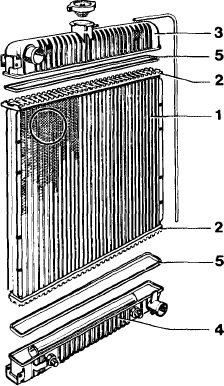 |
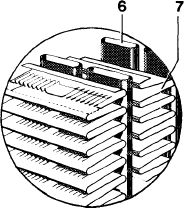 |
|||||||||||||||||||||||
|
1 Radiator core
2 Tube plate
3 Coolant tank top
4 Coolant tank bottom
|
5 Gasket
6 Cooling tubes
7 Ribs
|
||||||||||||||||||||||||
|
1204-8461
|
|||||||||||||||||||||||||
|
|
|||||||||||||||||||||||||
|
e) Beaded flange (connection between radiator core and coolant tank).
f) Heat exchanger of heating system.
|
|||||||||||||||||||||||||
|
|
|||||||||||||||||||||||||
|
20.2-425/2 F3
|
|||||||||||||||||||||||||
|
|
|||||||||||||||||||||||||
|
|
||
|
Damaged parts on coolant tanks which are exposed to higher loads, such as torn or broken fastening plates, cracks in fillet of connections, breaks and very long or large cracks on top should not be repaired, since the sealing compound can absorb very light loads only.
|
||
|
|
||
|
Plastic coolant tanks of radiators made by Behr can be exchanged by means of special tools or fixtures in Behr radiator repair shops or Inter-Radia service stations.
If required, contact nearest Behr repair shop or Inter-Radia service station to find out whether such repairs can be made there.
If this is not possible, the radiator must be replaced.
|
||
|
|
||
|
On heavy-metal radiators with plastic coolant tanks, soldering jobs on core may be performed only up to a distance of 20 mm from coolant tank, since otherwise the high soldering temperature will damage the gasket (5) and the coolant tanks (3 or 4). Leaks which are closer to coolant tank, should be sealed with sealing compound.
|
||
|
|
||
|
If the leaky spot can be clearly localized in installed condition, the radiator need not be removed. In such a case it will be enough to drain the coolant and to pressure-test the cooling system upon sealing.
|
||
|
|
||
|
20.3-425/3 F3
|
||
|
|
||
|
|
|||
|
When handling priming fluid and sealing compound observe the following:
The priming fluid is easily inflammable (observe safety rules, dangerous materials class A 1).
Acetic acid will be released up to complete cross linking (setting) of sealing compound. For this reason, avoid skin contact. Clean affected spots immediately with water and soap, rinse eyes with water and see doctor, if required.
|
|||
|
|
|||
|
Sealing
|
|||
|
|
|||
|
1 If the leaking spot cannot be accurately localized in installed condition, remove radiator (20—420).
2 Clean radiator.
|
|||
|
|
|||
|
3 Connect hose connections to self-made closing caps.
|
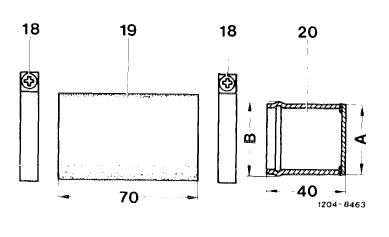 |
||
|
18 Clamp L 36-46 (part no. 916 026 036 000)
19 Hose section (part no. 123 501 13 82)
20 Cap made of 36 mm dia. tubing
|
|||
|
|
|||
|
On model 107, additionally close pipe connection for coolant flow from expansion tank on radiator.
|
|||
|
|
|||
|
18 Clamp L 20-27 (part no. 916 026 020 001]
19 Hose section (part no. 900 271 018 063)
20 Cap made of a piece of tubing
A = 18 mm dia., B = 19 mm dia.
|
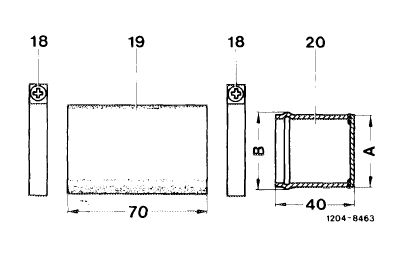 |
||
|
20.2-426/4 F3
|
|||
|
|
|||
|
|
|||
|
4 Close oil cooler connections with plastic caps or plugs from old oil cooler lines. For this purpose, saw off the oil cooler lines directly behind nipple and close by soldering.
|
|||
|
|
|||
|
5 Connect tester to radiator.
|
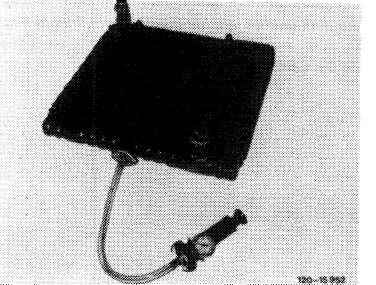 |
||
|
Radiator with filler neck
|
|||
|
|
|||
|
Note: On model 107.026 pull hose from radiator cap for leak test and attach to radiator overflow connection.
|
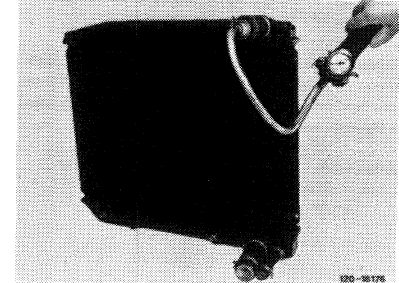 |
||
|
Radiator without filler neck
|
|||
|
|
|||
|
6 Place radiator into a water bath.
7 Put radiator under pressure with tester and watch where air bubbles are rising.
8 Mark leak.
9 Remove radiator and release pressure.
|
|||
|
|
|||
|
20.2-425/5 F3
|
|||
|
|
|||
|
|
||
|
10 Blow radiator dry with compressed air.
11 Clean spot to be sealed with a commercially available cleaner (e.g. Tri or benzine). Always clean slightly larger area than the spot to be sealed (e.g. for cracks approx. 20—30 mm beyond end of crack).
|
||
|
|
||
|
The paint need not be removed. Then blow radiator dry at respective spot by means of compressed air.
No dust and grease residue should remain.
|
||
|
|
||
|
12 Apply priming fluid uniformly and very thinly by means of a brush.
Similar to cleaning, apply priming fluid beyond spot about to be sealed. To prevent the priming fluid from getting dirty in tank, pour the required quantity into a separate vessel.
Attention!
Observe safety rules!
|
||
|
|
||
|
13 Let priming fluid dry at ambient temperature for approx. 10 minutes.
14 Set up radiator in such a manner that the sealing compound cannot run away from spot to be sealed.
15 Depending on accessibility, apply diluted or non-diluted sealing compound. Use a brush, a spatula or the like for distributing the sealing compound.
|
||
|
|
||
|
20.2-425/6 F3
|
||
|
|
||
|
|
|||
|
Attention!
During application and distribution make sure that no air pockets will occur.
Similar to cleaning and priming, apply sealing compound beyond spot about to be sealed. If there are several leaking spots on beaded flange (arrows), it will be of advantage to seal beaded flange all around.
Seal leaks in core from both sides.
|
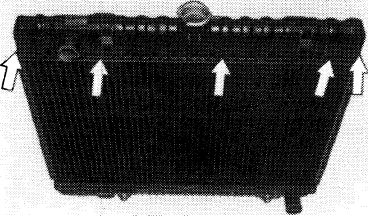 |
||
|
|
|||
|
At end of sealing procedure, close tube immediately. Acetic acid will be released up to complete cross linking (setting) of sealing compound. Avoid skin contact. Clean affected spots immediately with water and soap, rinse eyes with water, see doctor, if required.
|
|||
|
|
|||
|
16 Leave radiator lying or standing at least for 3 hours to dry sealing compound. Depending on quantity of applied sealing compound and size of sealed spot, complete cross linking (setting) of sealing compound into a permanent, elastic connection if completed after max. 24 hours at ambient temperature.
|
|||
|
|
|||
|
17 Pressuretest radiator in water bath for approx. 5 minutes at 1.5 bar gauge pressure.
If leaks are still showing up, repeat sealing procedure starting item 7.
18 Remove tester and locks.
19 Upon reinstallation of radiator, pressuretest cooling system with tester.
|
|||
|
|
|||
|
20.2-425/7 F3
|
|||
|
|
|||